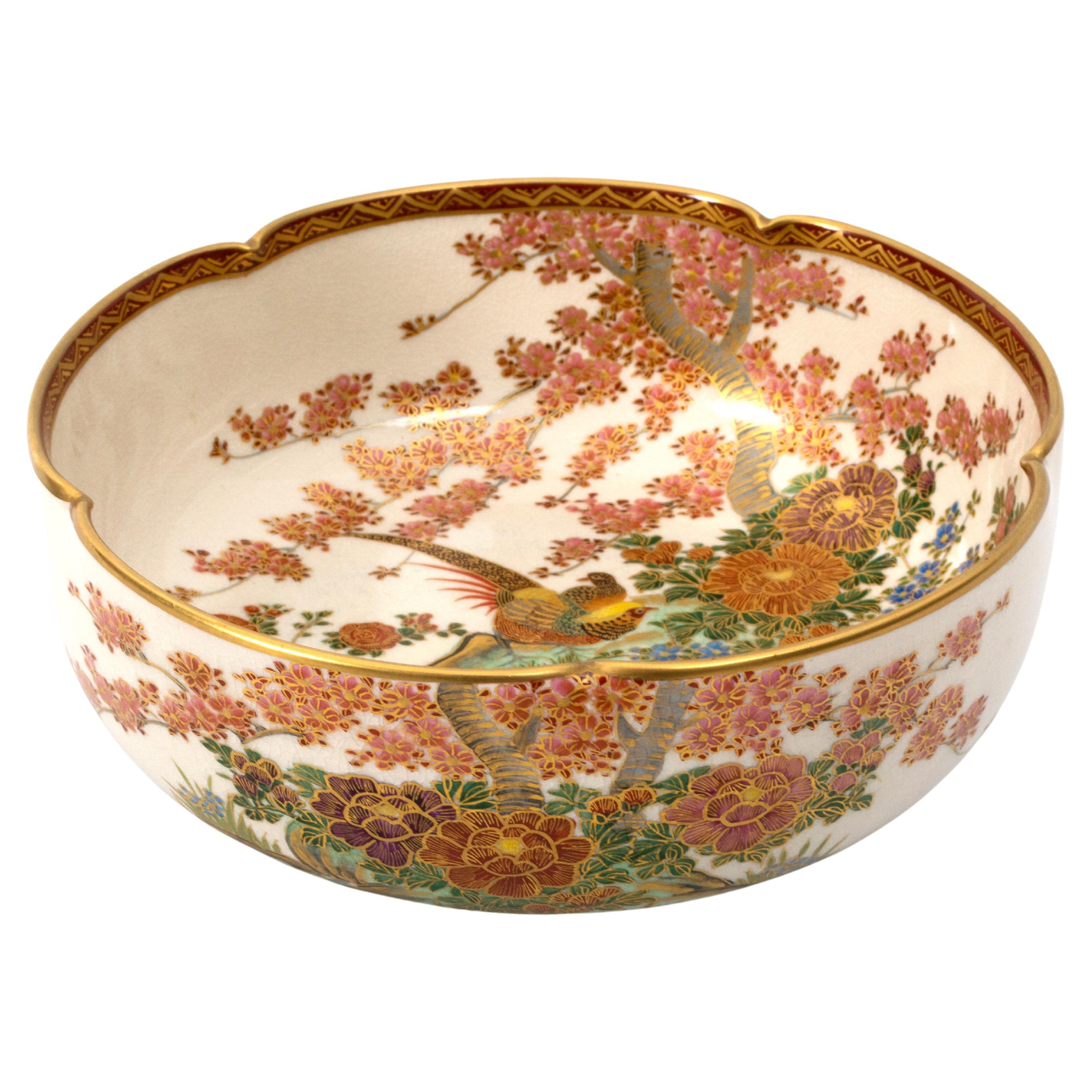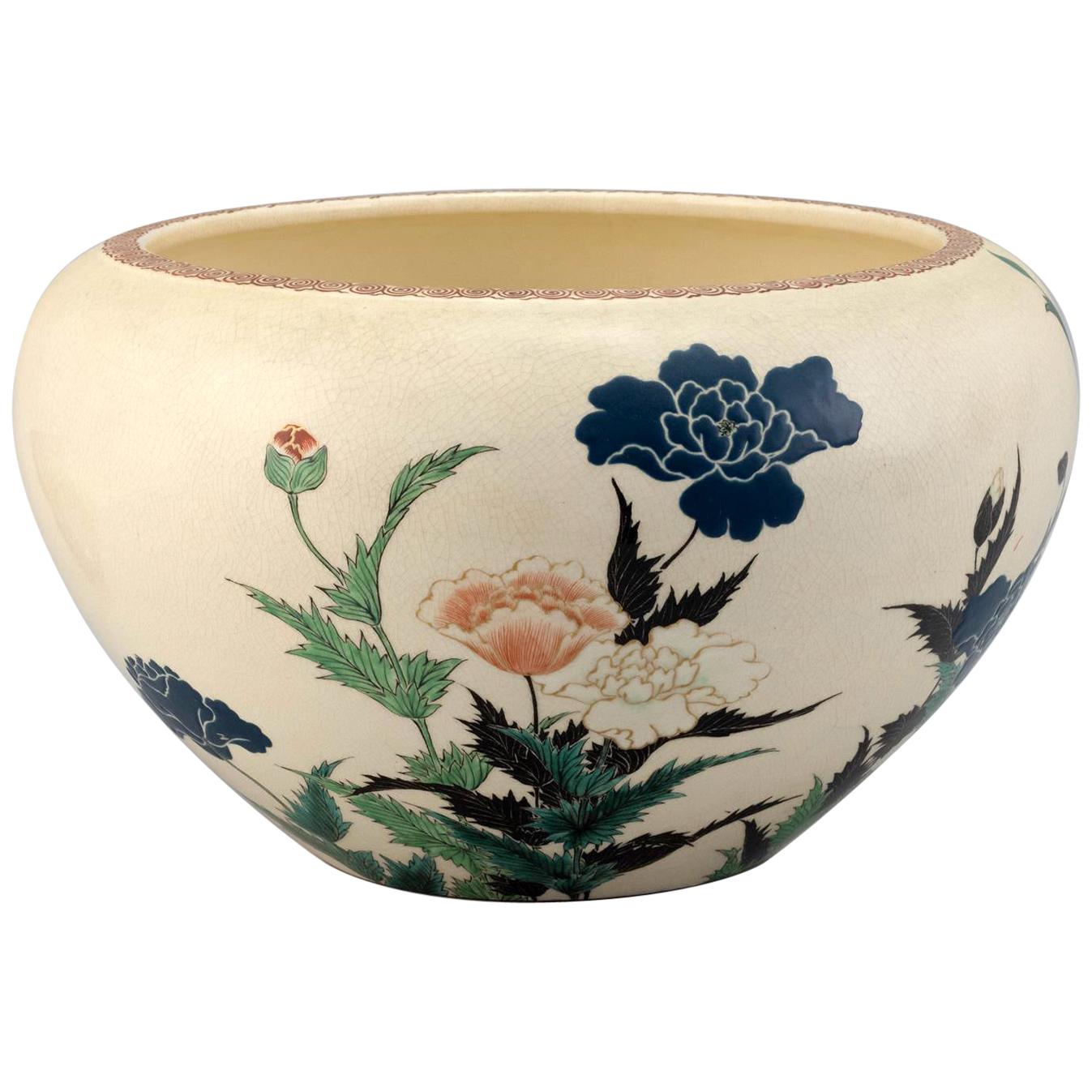Items Similar to Japanese Imari Bowl Centerpiece with French Ormolu Mounts, circa 1900
Want more images or videos?
Request additional images or videos from the seller
1 of 11
Japanese Imari Bowl Centerpiece with French Ormolu Mounts, circa 1900
About the Item
An elegant French Louis XVI style Japonisme centerpiece comprised of a large 19th century Meiji Period Japanese Imari Porcelain bowl with French gilt metal ormolu mounts, late 19th-early 20th century, France and Japan.
The 19th century Meiji Period Imari bowl of nice scale, with high walls and a slightly everted rim, and decorated in a traditional Imari palette of underglaze blue and white, over-glaze orange and green enamels, and gilt highlights.
The bowl designed with a geometric pattern of stylized pine bark with large peony blossoms and stylized brocade balls.
The ormolu mounts finely cast, comprising of a footed base and scalloped and rim with attached pair of handles.
The everted rim of the bowl fitted with an ormolu scalloped and pierced everted rim. A pair of handles flare dramatically outwards with an undulating design emulating the writhing bodies of dragons, terminating in large ruyi (nyoi), similar to the fleur-de-lis. The centerpiece is raised on an ormolu base, with the gilt feet wonderfully cast as charming and playful dragons chasing each other and holding sprigs of reishi - the fungus of immortality - in their mouths.
- Dimensions:Height: 9 in (22.86 cm)Width: 18 in (45.72 cm)Depth: 11 in (27.94 cm)
- Style:Japonisme (Of the Period)
- Materials and Techniques:
- Place of Origin:
- Period:
- Date of Manufacture:circa 1900
- Condition:Wear consistent with age and use. Minor fading. The gilt metal mounts with some discoloration as seen in photos.
- Seller Location:Austin, TX
- Reference Number:1stDibs: LU894719105172
About the Seller
5.0
Gold Seller
These expertly vetted sellers are highly rated and consistently exceed customer expectations.
Established in 2001
1stDibs seller since 2010
305 sales on 1stDibs
Typical response time: 1 hour
- ShippingRetrieving quote...Ships From: Austin, TX
- Return PolicyA return for this item may be initiated within 7 days of delivery.
More From This SellerView All
- French Ormolu Mounted Kangxi Period Famille Verte Porcelain CenterpieceLocated in Austin, TXThis gorgeous centerpiece has been created by the fortuitous marriage of a 17th century, Kangxi Period Famille verte enameled porcelain charger...Category
Antique Mid-19th Century French Chinoiserie Centerpieces
MaterialsBronze
- Japanese Imari Nanban Nesting Bowls, Set of 3, Showa Era, circa 1930s, JapanLocated in Austin, TXA wonderful set of three Japanese Imari Porcelain "Black Ship" Nanban nesting bowls, Showa Era or earlier, 1930s or earlier, Japan. The bowls wonderfully decorated in the Imari c...Category
Vintage 1930s Japanese Showa Ceramics
MaterialsPorcelain
- Large Japanese Imari Gilt Charger, the Six Immortal Poets, Meiji Period, JapanLocated in Austin, TXA bold and unusual large 18.5" diameter Japanese gilt ground Imari porcelain charger featuring the Rokkasen, the Six Immortal Poets, Meiji Period, circa 1900, Japan. The impressive charger features a striking image of the Six Immortal Poets, known as the Rakkasen, seated in fenced pavilion within a lush garden setting and surrounded by numerous books and scrolls. Gnarled pine trees and and branches laden with plum blossoms tower overhead, while chrysanthemum and massive peonies bloom among rocky outcrops. The scene is unexpectedly and masterfully executed as if on a byobu, a traditional Japanese six panel folding screen. The screen is opened in a dramatic manner, slightly akimbo, almost jumping off the dish, reminiscent of the "screens within screens" genre that developed during the Edo Period. Despite the folds and changes in perspective, the painting remains harmonious and lyrical, with the fully gilt ground adding a sense of warmth and sumptuousness. The screen is bordered with a geometric bands in the shippo pattern. The shippo pattern features interlocking circles, and symbolizes the Seven Treasures. The shippo pattern on a larger scale serves at the background fo the rest of the charger. The backside of the charger decorated with two bands with underglaze blue designs. The reserve decorated with scattered stylized blossoms in iron red and gilt. The Rakkasen, known in English as the Six Immortal Poets, are a group of 9th century Heian Period waka poets whose works were included and praised by name in an anthology of poetry collected by the courtier, poet, and writer, Ki no Tsurayuki. Waka poems are a strict five line...Category
Antique Early 1900s Japanese Meiji Ceramics
MaterialsPorcelain
- Large Japanese Imari Charger, Edo/Meiji Period, mid 19th century, JapanLocated in Austin, TXA large 18.25" diameter Japanese Imari porcelain charger, Edo to Meiji Period, mid 19th century, Japan. The large charger of near flattened form and decorated in the typical Imari palette of underglaze blue with red, orange and green overglaze enamels and gilt highlights. The design is centered on a roundel with a dense design of scrolling peony blossoms and leaves in underglaze blue. Two large pictorial reserves of Shinto priests...Category
Antique Mid-19th Century Japanese Meiji Ceramics
MaterialsPorcelain
- Large Japanese Imari Porcelain Charger with Koi, Meiji Period, late 19th centuryLocated in Austin, TXA boldly decorated large Japanese Imari porcelain scalloped edge charger with koi fish, Meiji Period, late 19th century, Japan. The large, shallow charger features a central design ...Category
Antique 1890s Japanese Meiji Ceramics
MaterialsPorcelain
- Japanese Imari Charger, Meiji Period, Late 19th CenturyLocated in Austin, TXA nicely decorated Japanese Meiji Period Imari charger, late 19th century, Japan. The porcelain charger featuring a design of a hoho bird, or phoenix, per...Category
Antique Late 19th Century Japanese Meiji Platters and Serveware
MaterialsEnamel
You May Also Like
- Antique Japanese Lobed Satsuma Bowl Meiji Period C.1900Located in London, GBAntique Japanese Lobed Satsuma Bowl Meiji Period C.1900 A Kobe Japan Satsuma bowl, of lobed pedestal form hand painted inside and out. A hand-painted natu...Category
Early 20th Century Japanese Ceramics
MaterialsEarthenware
- Japanese Studio Ceramic Centerpiece Okumura Shozan Meiji PeriodLocated in Atlanta, GAA beautifully crafted large ceramic bowl as a centerpiece by Okumura Shozan (1842-1905) in the Kyo-yaki (kyoto ware) style. A Classic ovoid form with flatly...Category
Antique Late 19th Century Japanese Japonisme Ceramics
MaterialsCeramic
- Japanese ormolu mounted Imari bowl & cover, c.1700. Edo Period.By AritaLocated in Gargrave, North YorkshireA large Japanese Imari bowl and cover, c. 1700, Arita, Edo Period, with 19th Century French ormolu mounts. The deep sided bowl, hand painted with alternating panels of flowering plan...Category
Antique Early 1700s Japanese Edo Ceramics
MaterialsPorcelain
- Meiji Period Large Japanese Imari Bowl CenterpieceBy Imari PorcelainLocated in Vero Beach, FLMeiji period large Japanese Imari bowl centerpiece This large, distinctive, octagonal porcelain Imari bowl is painted in rich, inky blue, co...Category
Antique 19th Century Japanese Meiji Ceramics
MaterialsPorcelain
- Japanese Porcelain PlateLocated in Atlanta, GAAn Japanese porcelain plate circa 1930s-1940s. Decorated with over glaze featuring three ladies in waiting. In the garden, the rock grottoes, a cherry tree in blossom, a half hidden banana tree and a few peeking peonies, suggest a subtropical scenery. The ladies were pictured as holding various item, a fly...Category
Early 20th Century Japanese Japonisme Ceramics
MaterialsCeramic
- Japanese Yoshidaya Saiko Kutani Ceramic DishBy YoshidayaLocated in Atlanta, GAA Japanese Ao-Kutani stoneware dish with overglaze decoration in the shape of barbed quatrefoil shape from late Edo period, circa early mid-19th century. Around 1804, 100 years after Ko-Kutani (old-Kutani) ware disappeared abruptly after thriving from 1655-early 1700s, saiko-kutani (revived-kutani) was attempted by many kilns and several distinguished styles developed. Among them, Yoshidaya kiln attempted to revive the original style of Ko-Kutani known as Aote, which employed four dark colors: green, yellow, dark blue/black and aubergine to create bold and striking design. The Yoshidaya production was short-lived and lasted roughly from 1823-1831. This dish is likely dated from this period or shortly after. The overglaze design centered around a crouching tiger under a black bamboo grove in a deep green background, surrounded by luxuriant banana leaves in green and aubergine with black outlines. The base of a similar concentric barbed quatrefoil design is further decorated with black foliage outlines and marked with a square Fuku mark. For a Yoshidaya dish with identical shape but different landscape decoration, see lot 79 of sale 6547 Christie's London. Important Japanese and Chinese Art...Category
Antique 19th Century Japanese Japonisme Ceramics
MaterialsCeramic
Recently Viewed
View AllMore Ways To Browse
Antique Silver Scale
Bowl With Feet
Antique Japanese Imari Porcelain
Imari Pattern
Glass Bowl With Metal
Antique Blue Glass Bowl
Blue Glass Bowl Antique
Blue Green Glass Bowl
Ormolu Glazed
Glass Scalloped Bowl
Large Glass Bowl Pattern
Silver Gilt French Furniture Handles
Orange Glass Bowls
Antique Enamel Bowl
Silver Bowl With Enamel
French Gilt Centerpiece
Antique Metal Bowl
French Green Bowl





